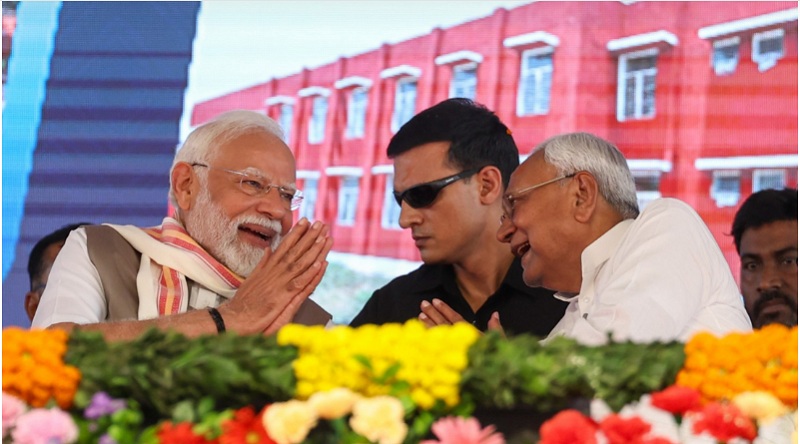By Satish K Jha
Legislative assembly elections in India are often fought and won on local issues. The overall national narrative, such as the national security rhetoric of Prime Minister Narendra Modi, can at best be an add-on to the prevailing regional issues.
Bihar is no exception to this, and its polarised political landscape with a sharp caste divide makes it even more difficult to sway the voter’s mood solely through issues like Operation Sindoor, India’s military operation against Pakistan, which was launched to avenge a terrorist attack.
Although the Bihar legislative election is due in October this year, Modi’s Bharatiya Janata Party (BJP), as well as the Opposition parties, have already started positioning themselves for the polls.
The significance of the Bihar assembly election can be gauged from the fact that both Prime Minister Narendra Modi and Congress party leader Rahul Gandhi have visited the state several times recently.
Modi’s choice of a public rally in Madhubani district in Bihar to announce his resolve to avenge the recent barbaric terrorist attack at Pahalgam in Jammu and Kashmir carried symbolic significance.
A recent poll survey conducted by C-Voter, however, suggests that Operation Sindoor is likely to have only a marginal impact on the mood of the electorate. Nonetheless, factors such as Modi’s strong leadership and his stance on Pakistan will certainly play a role during the BJP’s election campaign.
Caste census impact
The impact of free food distribution, LPG connections, and toilet construction for poor households often pushes Modi’s leadership rating above that of his opponents.
The Opposition’s poll plank of demanding a caste census may not yield significant gains for any political party in Bihar.
Modi’s initial resistance and vacillation, followed by his sudden appropriation of the caste census plank, means that all the political parties in the state support a caste census.
Both the Janata Dal (United), or JD(U), and the Rashtriya Janata Dal (RJD, the central fulcrums of the two opposing alliances — the National Democratic Alliance (NDA) and the Mahagathbandhan (the Opposition’s grand alliance) — were at the forefront of the campaign demanding a caste census. Hence, the credit gets evenly distributed.
Coalition of the willing
Bihar is the only north Indian state where political power has eluded the BJP without the support of an alliance.
Unlike in a parliamentary election, in Bihar the party cannot rely on Prime Minister Modi’s persona alone to secure victory.
Despite all major BJP leaders in the state coming from the Other Backward Classes (OBCs) and Extremely Backward Classes (EBCs), it has not been able to take on JD(U) leader Nitish Kumar or RJD leader Lalu Prasad on its own.
The BJP has not been able to groom a regional leader of any consequence.
For many years, it bet on Sushil Modi, a backward class leader. But that did not work. Then it propped up Samrat Choudhary, a backward caste Koeri leader. However, now the Koeri votes are being targeted by giving space to former JD(U) leader Upendra Kushwaha of the Rashtriya Lok Manch in the BJP-led alliance. The party wants to prop up a younger and more acceptable face to take on Tejashwi Yadav of the RJD.
The announcement by Chirag Paswan, son of the late Dalit leader Ramvilas Paswan, to contest the assembly election from a general seat (rather than a constituency reserved for Dalits) has fuelled speculation about BJP’s game plan. Although he is part of the NDA, Paswan appears to be preparing for a post-Nitish Kumar political vacuum in the alliance, which currently lacks a prominent state leader.
The BJP’s attempt to form a government without any major local ally in 2015 ended in a fiasco, depriving it of power for several years.
Chief Minister Nitish Kumar has reason to believe that the BJP can rule the state only in coalition with his party, the JD(U), and that he alone has the option of allying with both the RJD and BJP. He has done so twice in the past.
It is not that the BJP has not tried to dispense with Nitish Kumar. It tried and failed. However, that may not prevent it from trying again. Nitish Kumar is ageing and in indifferent health.
Besides, he leads a government facing 20 years of anti-incumbency.
The BJP may see this election as an opportunity to split the JD(U), possibly after the election. Whether Kumar survives the most difficult test of his political career will depend on the number of seats he wins and his ability to keep his flock together.
X-factors
The Bihar election has also become more interesting due to the entry of a new political party—Prashant Kishor’s Jan Suraaj Party (JSP).
The JSP is not a party born out of a mass movement. It is neither ideological nor a dynastic regional party.
It is more akin to a start-up led by ace election strategist Prashant Kishor, who aims to capitalise on misgovernance, the deteriorating law and order situation, and the outward migration of workers and students due to lack of industrialisation and the collapse of educational institutions.
The party is also targeting caste-agnostic voters in the state, as well as those who dislike the RJD but are averse to voting for the BJP and JD(U). CSDS-Lokniti data suggests that in 2020 many who traditionally voted for BJP were also reluctant to vote for JD(U).
If the JSP succeeds in poaching voters from both sides of the political divide, it may prove to be the X-factor in this election.
State of the Opposition
The Opposition Mahagathbandhan is heavily reliant on the father-son RJD duo of Lalu Yadav and Tejashwi Yadav, and their Muslim-Yadav voter base.
Despite being in Opposition, the RJD is not in a position to fully capitalise on the anti-incumbency against the government, owing to its two stints in a government led by Nitish Kumar. Still, with a vote share of around 23 percent, and an alliance with the Left parties and others, it remains a strong contender.
Much will depend, however, on whether non-committed voters outside the Muslim-Yadav base shift towards the RJD.
As for the Congress party, while it may be the sheet anchor of the Opposition alliance nationally, in Bihar it brings little to the table given its negligible organisational presence.
Though Nitish Kumar is down, he is not fully out of the race. He retains support among the EBCs, Mahadalits, and women voters of the state. But politically, he appears beleaguered and vulnerable, possibly fighting the last battle of his career.
The Bihar election will clearly be determined by local factors, with caste and anti-incumbency being crucial determinants of the electoral outcome. However, the yearning for change is palpable in Bihar, and the quest for a third alternative among voters makes the 2025 election wide open.
Satish K Jha is Professor of Political Science, Aryabhatta College, University of Delhi
Originally published under Creative Commons Attribution 4.0 by 360info™.















